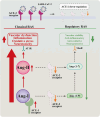Cognitive Sequelae of COVID-19: Mechanistic Insights and Therapeutic Approaches
- PMID: 40152069
- PMCID: PMC11950837
- DOI: 10.1111/cns.70348
Cognitive Sequelae of COVID-19: Mechanistic Insights and Therapeutic Approaches
Abstract
Background: The COVID-19 pandemic has left an indelible mark on the world, with mounting evidence suggesting that it not only posed acute challenges to global healthcare systems but has also unveiled a complex array of long-term consequences, particularly cognitive impairment (CI). As the persistence of post-COVID-19 neurological syndrome could evolve into the next public health crisis, it is imperative to gain a better understanding of the intricate pathophysiology of CI in COVID-19 patients and viable treatment strategies.
Methods: This comprehensive review explores the pathophysiology and management of cognitive impairment across the phases of COVID-19, from acute infection to Long-COVID, by synthesizing findings from clinical, preclinical, and mechanistic studies to identify key contributors to CI, as well as current therapeutic approaches.
Results: Key mechanisms contributing to CI include persistent neuroinflammation, cerebrovascular complications, direct neuronal injury, activation of the kynurenine pathway, and psychological distress. Both pharmacological interventions, such as anti-inflammatory therapies and agents targeting neuroinflammatory pathways, and non-pharmacological strategies, including cognitive rehabilitation, show promise in addressing these challenges. Although much of the current evidence is derived from preclinical and animal studies, these findings provide foundational insights into potential treatment approaches.
Conclusion: By synthesizing current knowledge, this review highlights the importance of addressing COVID-19-related cognitive impairment and offers actionable insights for mitigation and recovery as the global community continues to grapple with the pandemic's long-term impact.
Keywords: COVID‐19; brain; cognitive impairment; pathophysiology; pharmacological treatment.
© 2025 The Author(s). CNS Neuroscience & Therapeutics published by John Wiley & Sons Ltd.
Conflict of interest statement
The authors declare no conflicts of interest.
Figures







References
Publication types
MeSH terms
Grants and funding
LinkOut - more resources
Full Text Sources
Medical
Research Materials

